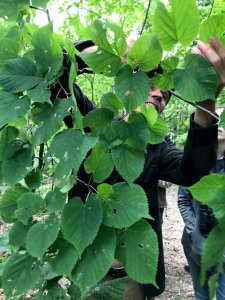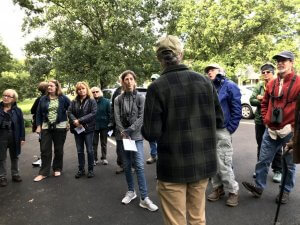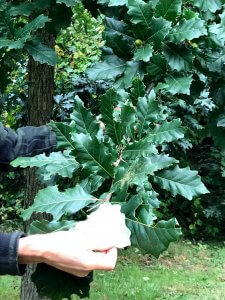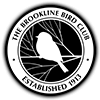Did you know that white ash, a bird‐friendly tree, has diamond patterns in its bark? Or, that 100‐200 organisms live inside leaves? More than 20 birders showed up Sunday morning for the Brookline Bird Club’s Tree Identiication walk led by Harvard University botanist Walter Kittredge, and learned this much and more. Toting binoculars and carrying a list of trees found in Belmont‐Watertown’s Beaver Brook Reservation, participants studied compound and simple, opposite and alternate leaves, bark textures, tree structures and soil preferences of specific trees. 
Walter described and passed around leaves from various species of oaks and maples, cherry, beech, birch and ash trees, so we could note differences and similarities among leaf shapes and content. Non‐native species such as glossy buckthorn, porcelain berry and oriental bittersweet unfortunately thrive at Beaver Brook, and we identified many examples of these highly invasive vines ‐ “the worst!” Throughout the walk, we considered reasons why certain trees support birds and wildlife better than others: in short, it’s about the insects and other creatures that live on the leaves and bark of some (native) trees and not others, so a chewed‐up, hole‐ridden leaf is generally a great sign of a bird‐friendly tree! Frequent references were made to Doug Tallamy’s Book, Bringing Nature Home, which makes the case for planting native oaks,  birches, maples and other native trees that support birds in many ways. At the end of walk, we arrived at and studied a young, impressive swamp white oak while watching a dozen American Robins, 2 Blackpoll Warblers, a Pine Warbler and a Red‐eyed Vireo consuming bittersweet berries and insects lurking beneath their dense foliage. Birders were not disappointed: we saw some late fall warblers and learned how and why they stopped at Beaver Brook to refuel on their ways elsewhere.
birches, maples and other native trees that support birds in many ways. At the end of walk, we arrived at and studied a young, impressive swamp white oak while watching a dozen American Robins, 2 Blackpoll Warblers, a Pine Warbler and a Red‐eyed Vireo consuming bittersweet berries and insects lurking beneath their dense foliage. Birders were not disappointed: we saw some late fall warblers and learned how and why they stopped at Beaver Brook to refuel on their ways elsewhere.

Note: the Brookline Bird Club is planning future conservation‐minded walks. Please check our website and massbird for announcements: https://brooklinebirdclub.org/
